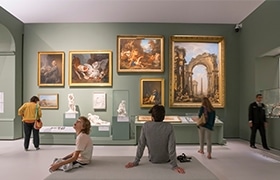How Cultural Institutions Are Leveraging Photo Archiving
Home » How Cultural Institutions Are Leveraging Photo Archiving
- October 18, 2018

Museums and cultural institutions play a valuable role in preserving the rich cultural heritage of our planet. By recording the history of different era and communities, such institutions help us understand our history, deepening our knowledge and respect for various cultures and traditions.
However, with time, the ways of accessing the history is changing. G. Wayne Clough, the author of Best of Both Worlds, says, “Today digital technology is pervasive. It is mandatory that museums, libraries, and archives join with educational institutions in embracing it.”
To keep with this trend, photo archiving has been a prime focus of many cultural institutions. Some forerunners in this space are:
Pharos
Pharos, the “International Consortium of Photo Archives” – a joint effort of 14 institutions like the Getty and the Frick, the National Gallery of Art, the Yale Center for British Art, Rome’s Bibliotheca Hertziana, and the Courtauld Institute among others will host 25 million images – 17 million artworks and 8 million supplemental material. The Consortium aims to have 7 million images online by 2020.
Primarily aimed at scholars, Pharos uploads a work’s provenance, attribution, exhibition, conservation, and bibliographic histories. The Consortium currently has more than 100,000 images and 60,000 artworks of early Christian art from the National Gallery, classical and Byzantine art and mosaics from the Frick, statuary from the Bibliotheca Hertziana, and photographs of Roman pottery among other collectibles.
Smithsonian Design Museum
Cooper Hewitt, popularly known as the Smithsonian Design Museum has embarked on an ambitious digitization project where they have digitized more than 92 percent of the 3000-year-old museum collection.
Durham Museum
The photo archive of the Durham Museum in Nebraska documents the history of Omaha in more than 1 million images from the 1860s. Dedicated to the long-term storage of photographs to preserve a part of the past, the photos document moments like Presidents on parade, streetcars, storefronts, and images from the early days of the city.
Oslo City Museum
The Oslo City Museum, with over 2 million objects, has started archiving photos to preserve the lifestyle, history, and development of the city in time. More than 100,000 photos have already been digitized in the museum’s system.
Norwegian Labour Movement Archives and Library
Four special groups are working together to organize the collection of Norwegian Labor Movement Archives and Library, which comprises of 1,500,000 items about Oslo History in general aspect and narrative about labor history.
Google has a similar project – Google Art Project – which lets users’ virtually tour 17 of the world’s major institutions like Ufizzi, New York Met, and Tate among others.
Benefits of photo archiving
While the benefits of archiving history are many, here is a list of the four prominent benefits:
- Reachability: With photo archiving, learning about history and culture is no more only restricted to museum booklets or guided tours. With web-based virtual walk-through and videos, museums and cultural institutions can reach out to a broader audience base.
- Multiple revenue sources: Photo archiving has opened new revenue sources for cultural institutions. Many museums have websites selling online tickets, replicas of artifacts, historical DVDs, and 3D immersive trips to let the audience experience history from the comfort of home.
- Long-term preservation of cultural heritage: Physical copies of photos and artifacts are subject to wear-and-tear and natural calamities. Digitization has made preservation of history easier and more accessible.
- Ease of research: Photo archiving has made researching on an era or finding the right image for a project easier. For example, Pharos, the Consortium of Photo Archives has made millions of photos accessible to the artists and researchers in a click, saving time and energy.
With digitization, consumers have easy access to media and information through connected devices, making sharing more accessible and faster. Hence, more cultural institutions are trying to expand their horizon to reach out to new audiences and digitize their collection for long-term preservation.

